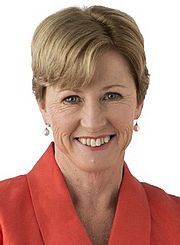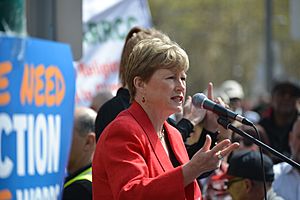Christine Milne facts for kids
Quick facts for kids
Christine Milne
|
|
|---|---|
 |
|
| Leader of the Australian Greens | |
| In office 13 April 2012 – 6 May 2015 |
|
| Deputy | Adam Bandt |
| Preceded by | Bob Brown |
| Succeeded by | Richard Di Natale |
| Deputy Leader of the Australian Greens | |
| In office 10 November 2008 – 13 April 2012 |
|
| Leader | Bob Brown |
| Preceded by | Position established |
| Succeeded by | Adam Bandt |
| Leader of the Australian Greens in Tasmania |
|
| In office 13 March 1993 – 29 August 1998 |
|
| Deputy | Peg Putt |
| Preceded by | Bob Brown |
| Succeeded by | Peg Putt |
| Deputy Leader of the Australian Greens in Tasmania |
|
| In office 13 May 1992 – 13 March 1993 |
|
| Leader | Bob Brown |
| Preceded by | Party established |
| Succeeded by | Peg Putt |
| Senator for Tasmania | |
| In office 1 July 2005 – 10 August 2015 |
|
| Succeeded by | Nick McKim |
| Member of the Tasmanian Parliament for Lyons | |
| In office 13 May 1989 – 29 August 1998 |
|
| Preceded by | Chris Batt |
| Succeeded by | Seat abolished |
| Personal details | |
| Born |
Christine Anne Morris
14 May 1953 Latrobe, Tasmania, Australia |
| Political party | Greens (since 1989) |
| Other political affiliations |
Independent (until 1989) |
| Spouses |
Neville Milne
(m. 1975; div. 1999) |
| Children | 2 |
| Education | St Mary's College Devonport High School |
| Alma mater | University of Tasmania |
| Occupation | School teacher (Department of Education) |
| Profession | Academic politician |
Christine Anne Milne (born 14 May 1953) is an Australian politician. She was a Senator for Tasmania, representing the state of Tasmania in the Australian Parliament. She led the group of Australian Greens members in Parliament from 2012 to 2015. Christine Milne stepped down from her leadership role on 6 May 2015.
Contents
Early Life and Education
Christine Milne was born in Latrobe, Tasmania. She was the second daughter of dairy farmers Tom and June Morris. She went to Wesley Vale Area School and later attended St Mary's College, Hobart. She finished her high school education at Devonport High School in 1970.
University Studies and Teaching Career
From 1971 to 1974, she studied history and political science at the University of Tasmania. She earned a Bachelor of Arts degree with Honours in Australian History. She also received a Certificate of Education in March 1975.
After university, Christine Milne worked as a high school teacher from 1975 to 1984. She taught English, History, and Social Science at several schools.
Early Environmental Activism
Christine Milne first became known for her work against building the Wesley Vale pulp mill. This mill was planned near Bass Strait in North Western Tasmania. She was worried about its impact on the environment.
She also took part in the successful campaign to stop the Franklin Dam from being built. In 1983, she was arrested and even jailed for her involvement in this protest.
Political Career Highlights
Christine Milne began her political career in 1989. She was elected to the Tasmanian House of Assembly as a member of the Tasmanian Greens. She was one of five Green politicians elected that year.
Leading the Tasmanian Greens
In 1993, when Bob Brown left his role, Christine Milne became the leader of the Greens in the Tasmanian Parliament. She was the first woman to lead a political party in Tasmania.
During her time as leader, the Greens worked with the Labor Party after the 1996 election. This led to important changes in Tasmania. These changes included new gun laws and fairer laws for gay people. There was also an apology to the Indigenous stolen generations. This refers to Indigenous children who were taken from their families.
In 1998, the number of seats in the Tasmanian House of Assembly was reduced. This made it harder for smaller parties to get elected. Christine Milne lost her seat in the election that followed.
Moving to Federal Politics
After her time in state politics, Christine Milne worked as an adviser for Senator Bob Brown from 2000. She was then elected to represent Tasmania in the Federal Senate in the 2004 federal election.
She became the Deputy Leader of the Australian Greens on 10 November 2008.
Leader of the Australian Greens
On 13 April 2012, Christine Milne became the leader of the Australian Greens. This happened after Bob Brown resigned. She led the Greens' main team of spokespeople in Parliament.
On 6 May 2015, Christine Milne announced she was stepping down as leader of the Australian Greens. She also said she would leave the Senate. She officially resigned from the Senate on 10 August 2015.


